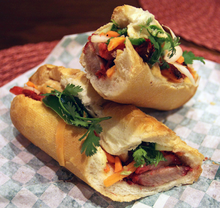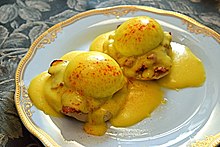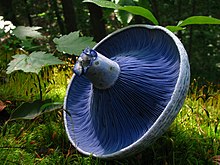Portal:Food
F o o d
A portal dedicated to food and foodways
Introduction


Food is any substance consumed by an organism for nutritional support. Food is usually of plant, animal, or fungal origin and contains essential nutrients such as carbohydrates, fats, proteins, vitamins, or minerals. The substance is ingested by an organism and assimilated by the organism's cells to provide energy, maintain life, or stimulate growth. Different species of animals have different feeding behaviours that satisfy the needs of their metabolisms and have evolved to fill a specific ecological niche within specific geographical contexts.
Omnivorous humans are highly adaptable and have adapted to obtain food in many different ecosystems. Humans generally use cooking to prepare food for consumption. The majority of the food energy required is supplied by the industrial food industry, which produces food through intensive agriculture and distributes it through complex food processing and food distribution systems. This system of conventional agriculture relies heavily on fossil fuels, which means that the food and agricultural systems are one of the major contributors to climate change, accounting for as much as 37% of total greenhouse gas emissions. (Full article...)
Cooking, also known as cookery or professionally as the culinary arts, is the art, science and craft of using heat to make food more palatable, digestible, nutritious, or safe. Cooking techniques and ingredients vary widely, from grilling food over an open fire, to using electric stoves, to baking in various types of ovens, reflecting local conditions. Cooking is an aspect of all human societies and a cultural universal.
Preparing food with heat or fire is an activity unique to humans. Archeological evidence of cooking fires from at least 300,000 years ago exists, but some estimate that humans started cooking up to 2 million years ago.
The expansion of agriculture, commerce, trade, and transportation between civilizations in different regions offered cooks many new ingredients. New inventions and technologies, such as the invention of pottery for holding and boiling of water, expanded cooking techniques. Some modern cooks apply advanced scientific techniques to food preparation to further enhance the flavor of the dish served. (Full article...)

French fries (North American English), chips (British English and other national varieties), finger chips (Indian English), french-fried potatoes, or simply fries are batonnet or allumette-cut deep-fried potatoes of disputed origin from Belgium or France. They are prepared by cutting potatoes into even strips, drying them, and frying them, usually in a deep fryer. Pre-cut, blanched, and frozen russet potatoes are widely used, and sometimes baked in a regular or convection oven; air fryers are small convection ovens marketed for frying potatoes.
French fries are served hot, either soft or crispy, and are generally eaten as part of lunch or dinner or by themselves as a snack, and they commonly appear on the menus of diners, fast food restaurants, pubs, and bars. They are often salted and may be served with ketchup, vinegar, mayonnaise, tomato sauce, or other sauces. Fries can be topped more heavily, as in the dishes of poutine, loaded fries or chili cheese fries. French fries can be made from sweet potatoes instead of potatoes. A baked variant, oven fries, uses less or no oil. (Full article...)
Selected article –
Hollandaise sauce (/hɒlənˈdeɪz/ or /ˈhɒləndeɪz/; French: [ɔlɑ̃dɛz], from French sauce hollandaise meaning “Dutch sauce”)
is a mixture of egg yolk, melted butter, and lemon juice (or a white wine or vinegar reduction). It is usually seasoned with salt, and either white pepper or cayenne pepper.It is well known as a key ingredient of eggs Benedict, and is often served on vegetables such as steamed asparagus. (Full article...)
Selected cuisine -

Soul food is the ethnic cuisine of African Americans. It originated in the American South from the cuisines of enslaved Africans trafficked to the North American colonies through the Atlantic slave trade during the Antebellum period and is closely associated (but not to be confused with) the cuisine of the American South.
The expression "soul food" originated in the mid-1960s when "soul" was a common word used to describe African-American culture. Soul food uses cooking techniques and ingredients from West African, Central African, Western European, and Indigenous cuisine of the Americas. Soul food came from the blending of what African Americans ate in Africa and what was available to them as slaves. The cuisine initially had its share of negativity. Soul food was seen as low-class food, and African Americans in the North looked down on their (formerly) Black Southern counterparts who preferred soul food (see The Great Migration). The concept evolved from being the food of slaves in the South, to being a primary source of pride in the African American community even in the North, such as in New York City. (Full article...)Selected ingredient –

Butter is a dairy product made from the fat and protein components of churned cream. It is a semi-solid emulsion at room temperature, consisting of approximately 80% butterfat. It is used at room temperature as a spread, melted as a condiment, and used as a fat in baking, sauce-making, pan frying, and other cooking procedures.
Most frequently made from cow's milk, butter can also be manufactured from the milk of other mammals, including sheep, goats, buffalo, and yaks. It is made by churning milk or cream to separate the fat globules from the buttermilk. Salt has been added to butter since antiquity to help preserve it, particularly when being transported; salt may still play a preservation role but is less important today as the entire supply chain is usually refrigerated. In modern times, salt may be added for taste. Food coloring is sometimes added to butter. Rendering butter, removing the water and milk solids, produces clarified butter, or ghee, which is almost entirely butterfat. (Full article...)
Selected recipe –

In Vietnamese cuisine, bánh mì or banh mi (/ˈbɑːn miː/, /ˈbæn/; Vietnamese: [ɓǎjŋ̟ mì], 'bread') is a short baguette with thin, crisp crust and a soft, airy texture. It is often split lengthwise and filled with meat and savory ingredients like a submarine sandwich and served as a meal, called bánh mì thịt. Plain bánh mì is also eaten as a staple food.
A typical Vietnamese roll or sandwich is a fusion of meats and vegetables from native Vietnamese cuisine such as chả lụa (Vietnamese sausage), coriander (cilantro), cucumber, pickled carrots, and pickled daikon combined with condiments from French cuisine such as pâté, along with red chili and mayonnaise. However, a variety of popular fillings are used, from xá xíu (Chinese barbecued pork) to even ice cream. In Vietnam, bread rolls and sandwiches are typically eaten for breakfast or as a snack. (Full article...)
Lactarius indigo, commonly known as the indigo milk cap, indigo milky, the indigo (or blue) lactarius, or the blue milk mushroom, is a species of agaric fungus in the family Russulaceae. It is a widely distributed species, growing naturally in eastern North America, East Asia, and Central America; it has also been reported in southern France. L. indigo grows on the ground in both deciduous and coniferous forests, where it forms mycorrhizal associations with a broad range of trees. The fruit body color ranges from dark blue in fresh specimens to pale blue-gray in older ones. The milk, or latex, that oozes when the mushroom tissue is cut or broken — a feature common to all members of the genus Lactarius — is also indigo blue, but slowly turns green upon exposure to air. The cap has a diameter of 5–15 cm (2–6 in), and the stem is 2–8 cm (0.8–3 in) tall and 1–2.5 cm (0.4–1.0 in) thick. It is an edible mushroom, and is sold in rural markets in China, Guatemala, and Mexico. In Honduras, the mushroom is called a chora, and is generally eaten with egg; generally as a side dish for a bigger meal. (Full article...)
Selected image –
Selected biography –
B. 27 May 1975
Jamie Trevor Oliver MBE OSI (born 27 May 1975) is an English celebrity chef, former restaurateur and cookbook author. He is known for his casual approach to cuisine, which has led him to front numerous television shows and open many restaurants.
Oliver reached the public eye when his series The Naked Chef premiered in 1999. In 2005, he opened a campaign, Feed Me Better, to introduce schoolchildren to healthier foods, which was later backed by the government. He was the owner of a restaurant chain, Jamie Oliver Restaurant Group, which opened its first restaurant, Jamie's Italian, in Oxford in 2008. The chain went into administration in May 2019. (Full article...)
Did you know (auto-generated) –

- ... that when Mexia Supermarket was abandoned because of its owners' bankruptcy, all of the food inside was left to rot for more than three months?
- ... that not all military rations are food?
- ... that the Indianapolis Community Food Access Coalition was created to resolve food deserts in the city of Indianapolis?
- ... that Miles Hadfield ensured supplies of food to Coventry during the Second World War Blitz?
- ... that Rosalind Creasy wrote a landmark book on edible landscaping?
- ... that staff at the vegan food brand VFC interact with internet trolls on social media platforms to grow their online brand?
More did you know –
Related portals
Food topics
The following are topics relating to food
Categories
Food list articles
- See also: Lists of foods and Category:Lists of drinks
The following are some Food list articles on Wikipedia:

- American cheeses
- Appellation d'Origine Contrôlée cheeses
- Apple cultivars
- Bacon dishes
- Bacon substitutes
- Basil cultivars
- Breads
- Breakfast beverages
- Breakfast cereals
- Breakfast foods
- British cheeses
- Cakes
- Candies
- Cheeses
- Cheese soups
- Christmas dishes (list)
- Cocktails
- Cookies
- Dishes using coconut milk
- Diets
- Doughnut varieties
- Egg dishes
- Fermented soy products
- Food additives
- Food additives (Codex Alimentarius)
- Foods named after people
- French cheeses
- French dishes
- Fried dough foods
- Fruits
- List of hamburgers
- Herbs and spices
- Hors d'oeuvre
- Indian dishes
- Indian snack foods
- Indonesian dishes
- Italian dishes
- Japanese snacks
- Japanese dishes
- Jewish dishes
- Kebabs
- Korean beverages
- Mango cultivars
- Moroccan dishes
- Pasta
- Pastries
- Philippine snack food
- Pies, tarts and flans
- Poppy seed pastries and dishes
- Potato dishes
- Puddings
- Raw fish dishes
- Rice dishes
- Rolled foods
- Sauces
- Seafood
- Seeds
- Sandwiches
- Snack foods
- Soft drinks by country
- Soul foods and dishes
- Soups
- Stews
- Street foods
- Tapas
- Turkish dishes
- Twice-baked foods
- Vegetable oils
- Vegetables
- Vodkas
Things you can do
Related WikiProjects
| Parent project: WikiProject Food and Drink | |
| Child projects: | Task forces: (All inactive) |
|
|
| Related projects: | |
New articles
Rules | Match log | Results page (for watching) | Last updated: 2024-06-08 19:24 (UTC)
Note: The list display can now be customized by each user. See List display personalization for details.
- Lort cha (edit | talk | history | links | watch | logs | tools) by Turaids (talk · contribs · new pages (3)) started on 2024-06-08, score: 10
- Tatsuki Mizuno (edit | talk | history | links | watch | logs | tools) by TSUBAME98 (talk · contribs · new pages (4)) started on 2024-06-08, score: 10
- Akihiro Wakabayashi (edit | talk | history | links | watch | logs | tools) by TSUBAME98 (talk · contribs · new pages (4)) started on 2024-06-08, score: 10
- Shun Mizutani (edit | talk | history | links | watch | logs | tools) by TSUBAME98 (talk · contribs · new pages (4)) started on 2024-06-08, score: 10
- Yua Tamiya (edit | talk | history | links | watch | logs | tools) by TSUBAME98 (talk · contribs · new pages (4)) started on 2024-06-08, score: 10
- Los Danzantes Oaxaca (edit | talk | history | links | watch | logs | tools) by Another Believer (talk · contribs · new pages (67)) started on 2024-06-08, score: 10
- Oryza coarctata (edit | talk | history | links | watch | logs | tools) by Peter coxhead (talk · contribs · new pages (12)) started on 2024-06-08, score: 20
- 2024 Korean Curling Championships (edit | talk | history | links | watch | logs | tools) by TracyFleuryFan (talk · contribs · new pages (7)) started on 2024-06-08, score: 10
- Michael Jordan's Steak House (edit | talk | history | links | watch | logs | tools) by Expandinglight5 (talk · contribs · new pages (1)) started on 2024-06-07, score: 30
- High Noon (seltzer) (edit | talk | history | links | watch | logs | tools) by BanjoZebra (talk · contribs · new pages (7)) started on 2024-05-25, score: 20
- Feeding America (edit | talk | history | links | watch | logs | tools) by Hey man im josh (talk · contribs · new pages (203)) started on 2024-06-07, score: 10
- Makohin (edit | talk | history | links | watch | logs | tools) by Altenmann (talk · contribs · new pages (164)) started on 2024-06-07, score: 10
- Chicken Bones (edit | talk | history | links | watch | logs | tools) by B3251 (talk · contribs · new pages (13)) started on 2024-06-07, score: 30
- Sissy Bar (Portland, Oregon) (edit | talk | history | links | watch | logs | tools) by Another Believer (talk · contribs · new pages (67)) started on 2024-06-06, score: 10
- Wunderbar (bar) (edit | talk | history | links | watch | logs | tools) by Brianda (Wiki Ed) (talk · contribs · new pages (4)) started on 2024-06-06, score: 10
- Sammy Haynes (edit | talk | history | links | watch | logs | tools) by Penale52 (talk · contribs · new pages (4)) started on 2024-06-06, score: 10
- Pachira insignis (edit | talk | history | links | watch | logs | tools) by BlakeALee (talk · contribs · new pages (1)) started on 2024-06-06, score: 10
- Biggio's (edit | talk | history | links | watch | logs | tools) by Another Believer (talk · contribs · new pages (67)) started on 2024-06-05, score: 10
- Scallion bread (edit | talk | history | links | watch | logs | tools) by Heeheemalu (talk · contribs · new pages (13)) started on 2024-06-05, score: 30
- Song Jae-jeong (edit | talk | history | links | watch | logs | tools) by Preferwiki (talk · contribs · new pages (3)) started on 2024-06-05, score: 10
- Beryl Shereshewsky (edit | talk | history | links | watch | logs | tools) by Samsmachado (talk · contribs · new pages (5)) started on 2024-06-04, score: 10
- Off the Griddle (edit | talk | history | links | watch | logs | tools) by Another Believer (talk · contribs · new pages (67)) started on 2024-06-04, score: 10
- The Captive of the Sahara (edit | talk | history | links | watch | logs | tools) by Lord Cornwallis (talk · contribs · new pages (54)) started on 2024-06-04, score: 10
- Apple bread (edit | talk | history | links | watch | logs | tools) by Heeheemalu (talk · contribs · new pages (13)) started on 2024-06-04, score: 20
- Chiang Yu-An (edit | talk | history | links | watch | logs | tools) by BemrXDD (talk · contribs · new pages (3)) started on 2024-06-03, score: 10
- John Greene (Nurse) (edit | talk | history | links | watch | logs | tools) by Sue8183 (talk · contribs · new pages (0)) started on 2024-06-03, score: 40
- Red Boat (edit | talk | history | links | watch | logs | tools) by Valereee (talk · contribs · new pages (5)) started on 2024-06-02, score: 10
- Agrosuper (edit | talk | history | links | watch | logs | tools) by FrederickEvans (talk · contribs · new pages (28)) started on 2024-06-02, score: 30
- Fowler Ltd. (edit | talk | history | links | watch | logs | tools) by EssNS (talk · contribs · new pages (26)) started on 2024-06-01, score: 10
- Nilla Wafers (edit | talk | history | links | watch | logs | tools) by Voorts (talk · contribs · new pages (42)) started on 2024-05-26, score: 10
- Solari's (edit | talk | history | links | watch | logs | tools) by Nolabob (talk · contribs · new pages (1)) started on 2024-06-01, score: 20
- Nasi katok (edit | talk | history | links | watch | logs | tools) by The Bangsawan (talk · contribs · new pages (22)) started on 2024-06-01, score: 20
- Justin Sterner (edit | talk | history | links | watch | logs | tools) by Muboshgu (talk · contribs · new pages (11)) started on 2024-05-31, score: 10
- Warankasi (edit | talk | history | links | watch | logs | tools) by Wiisstlo (talk · contribs · new pages (5)) started on 2024-05-26, score: 20
- Brennans Bread (edit | talk | history | links | watch | logs | tools) by Gatepainter (talk · contribs · new pages (3)) started on 2024-05-31, score: 20
- Karin-Lis Svarre (edit | talk | history | links | watch | logs | tools) by Ipigott (talk · contribs · new pages (7)) started on 2024-05-31, score: 10
- Indori poha (edit | talk | history | links | watch | logs | tools) by Apocheir (talk · contribs · new pages (4)) started on 2024-05-30, score: 20
- Tanuki (restaurant) (edit | talk | history | links | watch | logs | tools) by Another Believer (talk · contribs · new pages (67)) started on 2024-05-30, score: 10
- Ko Myeong-seok (edit | talk | history | links | watch | logs | tools) by Explicit (talk · contribs · new pages (7)) started on 2024-05-30, score: 10
- Savanyúság (edit | talk | history | links | watch | logs | tools) by Konnor Martin (talk · contribs · new pages (1)) started on 2024-05-29, score: 10
- Laal maas (edit | talk | history | links | watch | logs | tools) by SafariScribe (talk · contribs · new pages (224)) started on 2024-05-29, score: 30
- Furrundu (edit | talk | history | links | watch | logs | tools) by BaduFerreira (talk · contribs · new pages (3)) started on 2024-05-29, score: 50
- Hyman's Seafood (edit | talk | history | links | watch | logs | tools) by DMVHistorian (talk · contribs · new pages (4)) started on 2024-05-28, score: 10
- Pickup Coffee (edit | talk | history | links | watch | logs | tools) by Hariboneagle927 (talk · contribs · new pages (25)) started on 2024-05-28, score: 20
- Geoffrey Hawtin (edit | talk | history | links | watch | logs | tools) by Chromista (talk · contribs · new pages (1)) started on 2024-05-28, score: 10
- Palani Panchamirtham (edit | talk | history | links | watch | logs | tools) by Magentic Manifestations (talk · contribs · new pages (14)) started on 2024-05-27, score: 10
- Erismatopterus (edit | talk | history | links | watch | logs | tools) by Kevmin (talk · contribs · new pages (16)) started on 2024-05-27, score: 10
- Saskatoon berry pie (edit | talk | history | links | watch | logs | tools) by Reywas92 (talk · contribs · new pages (4)) started on 2024-05-27, score: 30
- Zus Coffee (edit | talk | history | links | watch | logs | tools) by Hariboneagle927 (talk · contribs · new pages (25)) started on 2024-05-27, score: 20
- Space Cola Wars (edit | talk | history | links | watch | logs | tools) by Artem.G (talk · contribs · new pages (14)) started on 2024-05-27, score: 10
- Conchas de Piedra (edit | talk | history | links | watch | logs | tools) by Another Believer (talk · contribs · new pages (67)) started on 2024-05-27, score: 10
- Torta Balcarce (edit | talk | history | links | watch | logs | tools) by Murmuring Rock (talk · contribs · new pages (4)) started on 2024-05-25, score: 20
Associated Wikimedia
The following Wikimedia Foundation sister projects provide more on this subject:
-
Commons
Free media repository -
Wikibooks
Free textbooks and manuals -
Wikidata
Free knowledge base -
Wikinews
Free-content news -
Wikiquote
Collection of quotations -
Wikisource
Free-content library -
Wikiversity
Free learning tools -
Wiktionary
Dictionary and thesaurus
















































